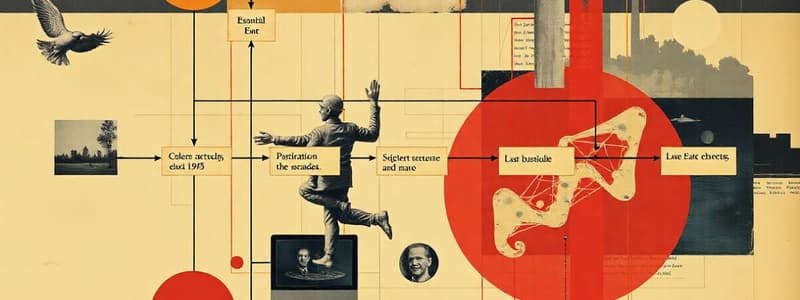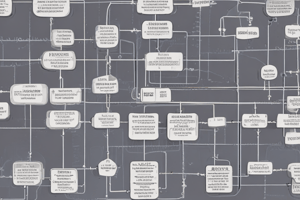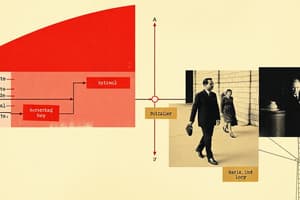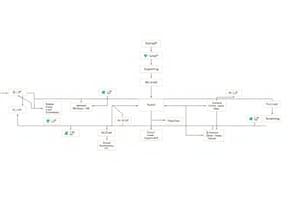Podcast
Questions and Answers
What is the main purpose of package diagrams?
What is the main purpose of package diagrams?
- To visualize data flow within a single class
- To outline the user interface design of an application
- To define formal packages like subsystems and informally group classes (correct)
- To showcase the visual representation of hardware components
Which of the following best describes a dependency relationship in package diagrams?
Which of the following best describes a dependency relationship in package diagrams?
- A relationship where a change in the independent component may require a change in the dependent component (correct)
- A direct relationship indicating classes that inherit from one another
- A relationship where one component must always be used with another
- An indication that changes in one component may not affect another
What are the responsibilities of the Domain Layer class?
What are the responsibilities of the Domain Layer class?
- Create persistent classes, process business rules, and prepare data for the database (correct)
- Contain all SQL statements and process results into domain objects
- Establish connections to external APIs and manage user sessions
- Display data input forms and manage user interactions
What is one of the responsibilities of the Data Access Layer?
What is one of the responsibilities of the Data Access Layer?
Which layer is responsible for capturing user input events such as clicks and key entries?
Which layer is responsible for capturing user input events such as clicks and key entries?
What is the purpose of return-value on the same line as the message?
What is the purpose of return-value on the same line as the message?
Which class acts as an intermediary between boundary classes and entity classes?
Which class acts as an intermediary between boundary classes and entity classes?
During system behaviour analysis, what is assigned to a conceptual class system?
During system behaviour analysis, what is assigned to a conceptual class system?
What characterizes a persistent class in object-oriented design?
What characterizes a persistent class in object-oriented design?
What is the main focus of object-oriented design?
What is the main focus of object-oriented design?
What does a boundary class represent in the context of system design?
What does a boundary class represent in the context of system design?
Which diagram is NOT typically associated with use case realization?
Which diagram is NOT typically associated with use case realization?
What is indicated by the visibility symbol (+ or -) in class attributes?
What is indicated by the visibility symbol (+ or -) in class attributes?
What is the primary purpose of a System Sequence Diagram (SSD)?
What is the primary purpose of a System Sequence Diagram (SSD)?
Which of the following best describes the notation for an outgoing message in a System Sequence Diagram?
Which of the following best describes the notation for an outgoing message in a System Sequence Diagram?
What is the primary characteristic of a concrete class?
What is the primary characteristic of a concrete class?
What does an asterisk (*) indicate in the message notation for SSD?
What does an asterisk (*) indicate in the message notation for SSD?
What is a key characteristic of the parameter list in a message name for SSD?
What is a key characteristic of the parameter list in a message name for SSD?
Which design principle emphasizes the separation of different responsibilities in classes?
Which design principle emphasizes the separation of different responsibilities in classes?
What is the goal of protecting parts of a system from variations?
What is the goal of protecting parts of a system from variations?
What type of information does a special case sequence diagram emphasize?
What type of information does a special case sequence diagram emphasize?
Which of the following statements regarding messages in SSD is true?
Which of the following statements regarding messages in SSD is true?
What does high cohesion in a class indicate?
What does high cohesion in a class indicate?
Which type of coupling is considered optimal in class design?
Which type of coupling is considered optimal in class design?
Which of the following is NOT a component of a System Sequence Diagram?
Which of the following is NOT a component of a System Sequence Diagram?
When using message formats in SSD, how should names be structured?
When using message formats in SSD, how should names be structured?
What does encapsulation refer to in object-oriented design?
What does encapsulation refer to in object-oriented design?
Which statement is true regarding the responsibilities of objects in a system?
Which statement is true regarding the responsibilities of objects in a system?
Which of the following best describes the principle of coupling?
Which of the following best describes the principle of coupling?
What is the primary goal of Agile development?
What is the primary goal of Agile development?
Which principle is emphasized in the Agile Manifesto?
Which principle is emphasized in the Agile Manifesto?
What does a product backlog represent in SCRUM?
What does a product backlog represent in SCRUM?
Who is responsible for controlling the backlog in SCRUM?
Who is responsible for controlling the backlog in SCRUM?
In Agile modeling, what is considered a crucial aspect of building models?
In Agile modeling, what is considered a crucial aspect of building models?
What defines a 'scrum sprint'?
What defines a 'scrum sprint'?
What is a critical attitude toward change in Agile development?
What is a critical attitude toward change in Agile development?
What is the main role of a controller in a system architecture?
What is the main role of a controller in a system architecture?
What role does open communication play in Agile development?
What role does open communication play in Agile development?
What does an activation lifeline represent in sequence diagrams?
What does an activation lifeline represent in sequence diagrams?
Which guideline should be followed when detailing messages in a sequence diagram?
Which guideline should be followed when detailing messages in a sequence diagram?
What assumption is made when designing a system according to the principles outlined?
What assumption is made when designing a system according to the principles outlined?
Which layer should be added to a multilayer sequence diagram to handle data interactions?
Which layer should be added to a multilayer sequence diagram to handle data interactions?
What is the purpose of separating user interface elements from application logic?
What is the purpose of separating user interface elements from application logic?
How can a new object be instantiated according to the provided methods?
How can a new object be instantiated according to the provided methods?
Which of the following is not a characteristic of a controller?
Which of the following is not a characteristic of a controller?
Flashcards
System Sequence Diagram (SSD)
System Sequence Diagram (SSD)
A diagram that shows the interaction between a user (actor) and a system for a specific use case, focusing on the sequence of messages.
SSD - Actor
SSD - Actor
The user or external system initiating interaction with the system in a specific use case.
SSD - system message format
SSD - system message format
It follows a structure of the name of the message, separated by upper-case letters and enclosed in parentheses, with parameters (if any).
SSD - Outgoing Messages
SSD - Outgoing Messages
Signup and view all the flashcards
SSD - Message Notation
SSD - Message Notation
Signup and view all the flashcards
SSD - Conditionals (brackets)
SSD - Conditionals (brackets)
Signup and view all the flashcards
SSD - Parameter List
SSD - Parameter List
Signup and view all the flashcards
Message Repetition in SSD
Message Repetition in SSD
Signup and view all the flashcards
System Operations
System Operations
Signup and view all the flashcards
Use Case Driven Design
Use Case Driven Design
Signup and view all the flashcards
Persistent Class
Persistent Class
Signup and view all the flashcards
Entity Class
Entity Class
Signup and view all the flashcards
Boundary Class
Boundary Class
Signup and view all the flashcards
Controller Class
Controller Class
Signup and view all the flashcards
Data Access Class
Data Access Class
Signup and view all the flashcards
Stereotype
Stereotype
Signup and view all the flashcards
Concrete Class
Concrete Class
Signup and view all the flashcards
Object Responsibility
Object Responsibility
Signup and view all the flashcards
Separation of Concerns
Separation of Concerns
Signup and view all the flashcards
Protection from Variations
Protection from Variations
Signup and view all the flashcards
Coupling
Coupling
Signup and view all the flashcards
Loose Coupling
Loose Coupling
Signup and view all the flashcards
Cohesion
Cohesion
Signup and view all the flashcards
Encapsulation
Encapsulation
Signup and view all the flashcards
Controller Role
Controller Role
Signup and view all the flashcards
Controller's Purpose
Controller's Purpose
Signup and view all the flashcards
Lifeline in a Sequence Diagram
Lifeline in a Sequence Diagram
Signup and view all the flashcards
Activation Lifeline
Activation Lifeline
Signup and view all the flashcards
Message Origins and Destinations
Message Origins and Destinations
Signup and view all the flashcards
Sequence Diagram for Design
Sequence Diagram for Design
Signup and view all the flashcards
Protection from Variations Principle
Protection from Variations Principle
Signup and view all the flashcards
Multilayer Sequence Diagrams
Multilayer Sequence Diagrams
Signup and view all the flashcards
Package Diagram
Package Diagram
Signup and view all the flashcards
Dependency Relationship
Dependency Relationship
Signup and view all the flashcards
Three-Layer Architecture
Three-Layer Architecture
Signup and view all the flashcards
View Layer Responsibilities
View Layer Responsibilities
Signup and view all the flashcards
Domain Layer Responsibilities
Domain Layer Responsibilities
Signup and view all the flashcards
Agile Development
Agile Development
Signup and view all the flashcards
Chaordic
Chaordic
Signup and view all the flashcards
Agile Values
Agile Values
Signup and view all the flashcards
Agile Modeling Principles
Agile Modeling Principles
Signup and view all the flashcards
SCRUM
SCRUM
Signup and view all the flashcards
Product Backlog
Product Backlog
Signup and view all the flashcards
Product Owner
Product Owner
Signup and view all the flashcards
Scrum Sprint
Scrum Sprint
Signup and view all the flashcards
Study Notes
ITM305 Final Exam - System Analysis and Design (Toronto Metropolitan University)
-
System Sequence Diagram (SSD): Shows interactions between an actor and the system for a use-case scenario. The system is visualized as a black box. Initiating actors and external systems are identified. The messages exchanged, and their sequence within the system, are detailed. Special cases for sequence diagrams illustrate object use within the system, highlighting inputs and outputs for a use case. Actor, system, and object lifelines are part of the diagram. Messages show content and structures of system inputs and outputs. Formatted messages in SSD follow UML format (lowercase letters, no spaces, using commas to separate parameters. Empty parentheses are used if no parameters needed)
-
Message Formats in SSD: Message names are followed by parameters. Names start with lowercase letters. Compound words are combined with uppercase letters as delimiters. Parameters are separated by commas. If no parameters exist, empty parentheses are used. True/False conditions are indicated by [true/false condition]. Return values, if any, are included with
:=. An asterisk (*) indicates repetition or looping. Brackets[]are used for true/false conditions. The message-name (verb-noun description) and a parameter-list (with parentheses, if applicable) denote the service and passed data. Return values (denoted by:=) return data between source and destination objects. -
System Events and System Operations: System operations are public, black-box functions offered by the system. These are triggered by external inputs/system events, initiated by actors.
-
Extending and Integrating Requirements Models: Includes use case diagrams, use case descriptions, activity diagrams, system sequence diagrams (SSDs), and domain class diagrams to illustrate use case realizations. Domain classes, using models, are part of the diagram.
-
Steps of Object-Oriented Design: Object-oriented design methods identify classes, their methods, and messages to complete a use case. The primary driving component in the design methodology is use cases.
-
Design Class Diagrams: Stereotype descriptions use guillemots (<< >>). Persistent classes persist after shut downs (e.g., data). Entity classes denote problem domain classes. Boundary classes represent system boundaries (input/output). Controller classes control communication between boundary and entity classes. Data access classes manage database interaction. A class's attributes have visibility (e.g. +public, −private).
-
Fundamental Design Principles (Week 9): Object responsibility, knowing and doing, separation of concerns, and protection from variations are core principles. Objects are fundamental to system processing. Segregation by class into groups or packages improves overall organization. Parts of a system less likely to change are separated to protect from major variations.
-
Quantitative Measurement of Coupling (Week 9): Measures how tightly related classes are linked, ranging from tightly to loosely coupled. Fewer associations or messages reduce coupling, which is the desired outcome.
-
Cohesion (Week 9): Measures internal unity of purpose in a class. High cohesion implies cohesive responsibilities (e.g., all customer-related responsibilities are in one class). Conversely, low cohesion suggests broad or mismatched responsibilities. Higher is better to increase system organization.
-
Encapsulation (Week 9): Bundles data with methods operating on that data within a single unit. Objects encapsulate data, using methods to hide data members/methods, improving system robustness. This decreases interdependence between system components.
-
Inheritance (Week 9): A mechanism to derive class attributes and methods from a parent (super) class into child (subsidiary) classes. Inheritance creates a hierarchy, inheriting from parents. It avoids redundant code. Parent/superclass attributes/methods don't need to be redefined in child/subclasses.
-
Indirection (Week 9): Introduces an intermediate class between interacting entities. Improves system decoupling, but still links them. Security can also be supported to handle messages and maintain robustness. Example including a controller class between UI and problem domain classes.
-
Polymorphism (Week 9): Allows same-named methods with differing parameters in the class. Reduces code, improving the flexibility and extensibility of class systems within a given class, using same names with different parameters which provides different operations or implementations for each use.
-
Use Case Controller (Week 9): Acts as a switchboard between user interfaces and domain layers. Reduces coupling between layers, improves organization and maintains a central location for directing communications between system layers. It can be created for a use case or group of related use cases (e.g., artifact).
-
Understanding Sequence Diagrams (Week 10): Sequence diagrams clarify interactions between system objects and actors, using lifelines, activations, and messages. The dashed lines under objects are lifelines, which are origin/destination points for messages. Activation (vertical box on the lifeline) indicates actions. Messages (arrows) identify exchanges and return values.
-
OOD with Sequence Diagrams (Week 10): Guides use case selection, creation of initial Data Class Diagrams (DCDs) and extending the DCDs with further messages (add input messages).
-
Guidelines for Sequence Diagrams (Week 10): Details the format of the input use case messages, the messages, determining origin and destination objects, elaborating messages. Fleshing out each message with true/false, parameters, and return values.
-
Assumptions for Sequence Diagrams (Week 10): Assumes a perfect technology, no logon or tech issues, and no exceptions are handled which maintains a simplistic view of the system.
-
Fundamental Design Principles (Week 10): Emphasizes Protection from Variations: Separating parts of a system that are likely to change from those that remain stable (e.g., UI vs application logic).
-
Multilayer Sequence Diagrams (Week 10): Incorporates view layers and data layers for input handling and data access. View layer manages input screens, sends messages to the data layer, which accesses relevant data systems.
-
Data Layer (Week 10): Handles persistent object reading and updating, including reading/writing data to systems. Instantiate objects and send messages managing data persistence. Methods provide data access and object instantiation.
-
Package Diagrams (Week 10): Categorize, group, and visually represent classes or subsystems within the system. Package usage creates a method of classifying components/subsystems in the system. A dependency relationship, indicated by dashed lines, denotes a component/module dependency.
-
Implementation Issues Three Layer Design (Week 10): Lists Responsibilities of the View Layer for handling user interactions and reports, displaying data as well as receiving and validating user input.
-
Agile Development (Week 11): A philosophy and guidelines, emphasizing responding to change and customer collaboration over plans and documentation in a rapidly changing environment. Chaordic projects, as a guide, refer to chaotic yet ordered projects.
-
Agile Values (Week 11): Emphasizes customer collaboration and working software, not comprehensive documentation or sticking to strict plans. This leads to flexibility, adapting to changing environments.
-
Agile Principles (Week 11): Describes responsive project design and development values, in contrast to fixed plans, using principles (build only necessary, next effort as secondary goal), minimizing modeling efforts to achieve forward movement, adapting to change, which can reversed if necessary. All build on the fundamentals of understanding and communicating requirements during the software development cycle.
-
SCRUM (Week 11): Combining principles of rugby and agility in software development, using time-boxed projects as important methodologies. Scrum methods are used for project management.
-
Scrum Sprint (Week 12): Project implementation, time-boxed, part of the system.
-
Product Backlog (Week 12): A prioritized list of user requirements for the system, to be followed in the project management cycle.
-
Product Owner (Week 12): The client stakeholder who controls the product backlog, as part of the project management cycle.
-
Scrum Master (Week 12): The project manager who leads and supports the project team, as part of the project management lifecycle.
-
Domain Layer Classes (Week 12): Classes related to the problem being solved. They carry out the business logic and are the core of the system. This can include creating and managing data storage, such as data persistence (database).
-
Data Access Layer Classes (Week 12): Responsible for data interaction with the database. Functions include establishing database connections, executing SQL statements on databases, and converting database result-set information into domain objects.
-
Domain Layer and Data Access Layer Responsibilities (Week 12): Details specific responsibilities of the Domain (business logic) and Data Access layers to be considered.
-
Start and Shutdown (Week 12): The initiation and completion of system operations and activities.
Studying That Suits You
Use AI to generate personalized quizzes and flashcards to suit your learning preferences.
Related Documents
Description
Test your knowledge on System Analysis and Design concepts with a focus on System Sequence Diagrams (SSD). This quiz covers key topics like interactions, message formats, and UML conventions that are critical for understanding system use-case scenarios. Perfect for Toronto Metropolitan University students preparing for their final exam.




